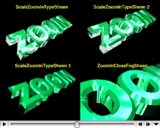
 |
|||||||
|
|
|||||||

|
Marie-Helene Robert website |
|
|
|
Size:
190 ko
Platform: Mac/PC |
|
infos: |
| Animating a Moving Sheen Effect |
 |
EIAS-List Abstract: If you want a big fat highlight band to move across the surface, or a square "softbox" highlight, you will prob'ly need to use an animated reflection map, much as you'd create one in AfterEffects. On the other hand, you could also apply a still reflection map to your logo and use the moving sheen trick. For simplicity's sake, try it with a single still object first (and maybe print this before you do?) Watch the Quictime movie (350Ko) |
1. Apply a still reflection map of your choice to your logo, putting it in the 3rd texture slot, which defaults to spherical mapping (for ex. Draw 10 black/white diagonal lines across your image map in Phshp).
2. Create an effector (null object).
3. Link all objects in your scene to the effector (including camera, lights, and logo). If I remember right, for complex models it is a good idea to link your lights to the camera itself before linking to the effector(???).
4. Rotate the effector approx. 0.4 degrees by frame for the duration the sheen will be animated (ex: 60 frames animation = rotate effector 24 degrees around Y) for a smooth moving sheen.
If all is linked correctly, your scene will appear the same as it did before you linked it to the rotating effector, even though everything is actually rotating, but the rendered animation will show a diagonal sheen moving slowly across your reflective object.
Although this is all simpler and faster to test with absolutely still objects (camera, lights, and logo) it can also be done quite easily after each of these objects has been animated on its own.
Clear as mud?
Marie-Helene
Once more, just in case: What this accomplishes is that your whole scene is rotated around the world just as your whole setup would be if you'd put the camera, lights, and reflective object on a rotating platform. Focus your camera on the reflective object, then spin the platform inside a zebra-painted room: the zebra reflection will appear to move on the reflective object's surface, while the camera itself looks absolutely still. Cool thing about computer graphics is that the zebra room is invisible to the camera, save for its reflection in the mapped object.
Must be related in at least one small way to these movie sequences where we see 2 dancers performing at normal speed while other dancers just blur/spin past them (the camera on a spinning platform/effector of some sort, I guess).
 |